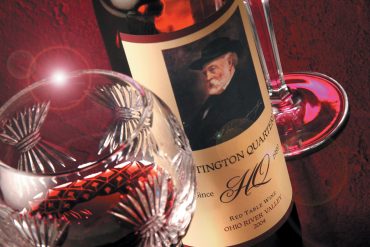By Joseph Platania
HQ 6 | WINTER 1991
One of Huntington’s great business assets is its world-famous glassmaking industry. To the west of the city, below the Tri-State Airport near Ceredo, is the Pilgrim Class Co., known throughout the nation for its handmade glassware.
Pilgrim Glass has gained extra attention in the last few years. For example, on Dec. 11, 1988, Academy Award winner Dustin Hoffman was given a hand-blown cameo bowl made at Pilgrim when he attended a benefit film screening of Rain Man at the Keith-Albee Theater and a benefit dinner at the Radisson Hotel. The bowl, called Midnight Cameo, was designed by P. Kelsey Murphy, director of Pilgrim’s art glass division. The black-over-cranberry design was made with three layers of blown glass. Cranberry, crystal and black glass were blown into a base, then heated and spun into a bowl shape before the design was carved into the surface. While the bowl took about eight hours to create, nearly 50 hours went into the bowl’s design which has been added to Pilgrim’s line. Pilgrim was the first American glass house to master the six-stage production of multi-layered cameo glass, according to Murphy.
David Davies, general manager and vice president of Pilgrim, said the company is following the trend of having one-of-a-kind studio art glass pieces signed by the artist. Sometimes the pieces are made to carry out a client commission, other times to satisfy the creative urge of the sculptor or designer. Davies said business in the Tri-State is up and tours have brought in business from places such as California, Nevada, Florida, Nebraska, Maryland, Michigan and Texas. A New York businessman established the site of Pilgrim Glass on Airport Road in 1956. Before that it was a small operation in the Westmoreland section of Huntington. In 1968, the current facility opened with tangerine, amethyst, smoke, sapphire, green and crystal coming off the production line. Pilgrim is noted for its unique Cranberry glass which is made by fusing solid gold and leaded crystal. Adding to Pilgrim’s history has been what Davies has termed the Italian influence. In the 1950s two brothers and a brother-in-law came from Italy where they had been trained in the famous Murano Glass Center. There, Alessandro Moretti and the late Roberto Moretti and Mario Sandon received their training when the craft of glassmaking was taught by a father to his sons. Sandon later married a sister of the Morettis. During his career, Roberto Moretti designed for Chagall, Cocteau, Picasso and other many awards for his work. His brother Alessandro has retired but still does special designs for Pilgrim. Mario Sandon, also retired, continues to create special commissions for “Glass Menagerie” – a carved glass animal collection.
Glass reflects the individuality of its creator and the spirit of the age. Mario Sandon, Kelsey Murphy and the Moretti brothers are exceptional, but there are other master craftsmen, mostly anonymous, in West Virginia’s glassmaking industry.
The state’s glass history goes back to 1864 and the development by a Wheeling plant of a revolutionary soda-lime formula for glass. This formula helped the state become a major glass producer. The Ohio Valley is well suited to glassmaking with its cheaper river transportation, an abundance of coal and natural gas to fire the furnace and a supply of silica for the glass formula. Industrial growth after the Civil War guaranteed a skilled labor force of native and immigrant craftsmen. Today, the valley remains a production center with nearly three-fourths of America’s handmade glass coming from the region.
Observing the glassmaking process on the floor of a glass house like Pilgrim’s is to witness an almost Biblical transformation of base elements into three-dimensional objects of grace and beauty. Reduced to its lowest common denominator, glass is nearly two-thirds sand, combined at high temperatures and melted down with elements such as potash, soda and lime.
When glassmakers add other chemicals to the raw ingredients, colors are created. One West Virginia glass house lists sugar, iron and sulphur as the additives for its amber glass; copper for blue; iron or chromium produces green, and selenium and cadmium sulfide produce orange. Oxide of lead often is added to produce glittering crystal.
Glass is born of flame and receives its baptism of fire in either the enclosed fireclay cauldron of a pot furnace or the larger day tank furnace, where raw ingredients and additives melt down into glass. The clay pots are in a furnace which circulates the flames outside the pots but where no flame touches glass being brewed.
The molten glass eats at the pots and must be replaced about every five months. A dozen pots are heated at once in a main pot furnace. Furnaces with a single pot, which can hold 2,400 pounds of glass, are the smallest used in a factory. The day tank is three times the size of a pot and melts glass by fire directly on the batch. The pot melt takes 24 to 30 hours, but a day tank needs only half that time. Temperatures of 2,500 degrees, the hottest outside a steel mill, are used to melt the batch.
After the melt, the molten glass is fluid, weighs 150 pounds per cubic foot and is the consistency of taffy.
The jargon associated with glassmaking, words like gob, blow shop, stamper and glory hole, is vivid, earthy and blunt. Molten glass is hot metal to the glassworkers. The jargon is similar to that of the coal and steel industries with which West Virginia’s glass factories have coexisted for decades. The craftsmen are given self-descriptive titles of gatherer, presser, blower and finisher.
Most of the glassmakers are middle aged men. Younger assistants bring in the hot glass from the furnaces at the center of the factory floor. They help with glassmaking and pick up the finished pieces. Together, the skilled artisans and their helpers make vases, pitchers, plates, jars, glasses, baskets, paper weights, figurines, slab glass, stained glass and other glassware in a rainbow of colors and designs.
In the first step of the process, the molten glass or gob is removed from the furnace on a long, metal ceramic tipped putty or point, or on a blowpipe by the gatherers, who peer into the white heat of the furnace. They must judge the proper amount of glass to gather so each piece of glassware gets started on its way neither too heavy nor too thin. The speed at which the putty is turned, together with the size of the tip, determines the amount gathered. A large piece sometimes requires as much as 10 pounds of glass. He also must shape the gob properly and drop it into the center of the press mold if pressed glass is being made.
The glowing, molten gob is now in the hands of the presser, who snips off the glass dropped into his mold by the gatherer and flips the cut end back into the mold to prevent a shear mark. He then pulls the lever and holds it for just the right amount of time to form the hand-pressed glass.
In the blow shop, the process is similar. Here, the gatherer forms a globule of hot glass on a hollow blowpipe and delivers it to the blocker, who cools and shapes the gob in a wooden block placed in a tub of soapy water and gives the piece its first bubble of air. After breathing life into the shapeless gob of glass, the blocker hands it to a carry-over boy who delivers it on the end of the blowpipe to the blower.
The glassblower is the figure most associated with glassmaking. It is he who first reheats the roughly shaped piece in a mini-furnace called a glory hole and rolls the ball of glass on a flat steel marver plate to obtain a shape similar to that of the blow-mold.
The glassblower often stands on top of the traditional blower’s wooded platform. Sometimes 3 feet high with six wooden steps, the platform looks like a small stage, but it is purely a functional arrangement to accommodate the long blowpipe, the gob and the blow mold. The blower receives the pipe from the carry-over boy and with his breathe forces a bubble-cavity of air into the hot ball of glass. With a wet, scoop-shaped block and a wooden paddle and a tong-like tool called a pucella, the glass is shaped to fit the mold into which it is to be blown. It takes years of experience to accomplish this task repeatedly, for all this must be done without a moment’s hesitation.
The glass form is then blown out farther and inserted into a water-soaked mold of cherry or applewood where it is expanded and continuously rotated.
When the piece is sufficiently expanded within this wooden mold, it is withdrawn. The glass is allowed to cool slightly as it comes from the mold. A helper attaches a long pontil rod, tipped with a bit of hot glass, to the center of the new piece. The piece is cracked off near the end of the blowpipe by chilling water, then carried to the finisher who reheats it. The ragged, uneven edge is then cut off, leaving a clean, straight edge. From the molds, the glass in transition is placed in a snap and reheated at the glory hole until it becomes hot enough to be crimped, flared or straightened by the finisher.
The glass finisher is perhaps the maestro on the busy factory floor. The glass form is completely crafted by him to the design indicated in the working drawing. He flares the piece, crimps it, changes its shape with an artist’s eye, adds glass to it and straightens the stem on footed pieces. He is like a sculptor finishing a carving, but instead of having days or weeks, the glass finisher must work within minutes or the medium becomes immovably chilled.
As one hand holds the rods on which the glass is attached, the finisher quickly turns, lifts and lowers the piece. The other hand uses the tools of the craft: the tong-like pucellas and a small wooden paddle. The finisher then removes the finished object from the rod with a file-like tool and a gentle blow on the rod. It is like the severing of an umbilical cord as the new piece of glassware enters the world. The carry in boy then receives the new piece on an implement called a fork and places it in a lehr or annealing oven to emerge three and a half hours later as a finished piece.
Another specialist in the glass factory is called the handler, for his craft is putting the handles where needed on glassware. Working as rapidly as the finisher, the handler attaches a glowing ribbon of hot glass to a piece, forms a loop and attaches the other end.
Like the handler, the vase swinger is a skilled specialist. He first reheats the top of a thick-walled goblet in the glory hole, loosening its molecules with fiery heat until it is pliable.
He then swings the glowing glass in soaring arcs while centrifugal force draws it into a slender vase as if it were red-hot taffy. The final shape of the vase will depend on the speed he swings the piece, the time he allows the vase to cool and the number of revolutions he makes with it.
The pressures placed on man and machine working a substance at 2,000 degrees enforce a special work schedule. Each eight-hour shift is divided in half.
The glassworker cannot produce two identical pieces of handmade glass. A pair of vases that, to the unaided eye, seem to match perfectly, will contain slight variances since they are the product of human hands and not machines.
Walking on a plant tour to observe the glassmaking process is like stepping back across a century or more of time to an age when open fires and handcrafted products were commonplace.
In fact, handcrafted glass is made much as glass was made 150 years ago. To observe incandescent globules of molten glass being transformed into glittering objects of stylish beauty in an environment akin to a steel mill reaffirms the glassmaker’s art as fiery magic.





